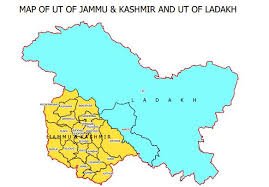KASHMIR’S TOLERANCE HOAX – true kashmiriyat is reflected in its seven hindu exoduses



Kashmir is unique at least in one respect. This is one geography within the Indian subcontinent that has a recorded history that fits the norms of western historiography. Kalhana’s Rajatarangini is a classic in its own right. It records the history of Kashmir over several centuries.
Even though Kalhana starts the history of Kashmir from the time of Gonanda I, in about the 7th century of the Kali Era,[1] its correct chronology is established during the times of the Karkota Dynasty. Its most illustrious king, Lalitaditya Muktapida (697–733 CE), is reputed to have extended the Karkota Empire from the edge of the Caspian Sea to Prāgajyotisha (Assam) in the East and the boundary of the Rashtrkutas (Deccan) in the South.
The reign of the Karkota, Utpala and Lohara dynasties were marked by the great renaissance in the field of art, literature, science, mathematics, spirituality, logic and all-round material development. The greatest polymath Abhinavagupta shines as the brightest gem of Kashmir, having lived there in the 10th and 11th centuries. He is also credited with having taken the practice of Kashmir Shaivism to its peak. He was also a great scholar in many other scholarly fields.
The Utpala and Lohara dynasties succeeded the Karkotas and had a clear run till 1315 CE. The period between 1315–1339 CE is a period of strife marked by changing kings and a lot of instability. Suhadeva, the last stable king of the Lohara dynasty ruled till 1320 CE. He also made the mistake that many kings have made throughout the history of India. He gave shelter and position to Shah Mir from Swat Valley (some other versions dispute this origin) to the Chaks from Dardistan near Gilgit to Bulbul Shah and Rinchan from Ladakh. After a Turkish invasion in 1320, and the death of Suhadeva, the valley fell into confusion. Scheming aliens brought the Valley to its knees. Queen Kota Rani, the widow of Suhadeva’s brother, Udayanadeva, offered resistance for a while. There are conflicting accounts about her end.
The popular version among Kashmiri Pandits has it that she married Shah Mir and died on the wedding night. Whether she was treacherously killed by Shah Mir or committed suicide is disputed.
Shah Mir took the throne in 1339 CE. He took the name Shams-ud-Din. In the reign of Qutub-ud-Din, the Kubrawiya Sufi, Sayyid Ali Shah Hamadan (Shah-e-Hamadan) came to the Valley and pursued the Islamisation project in right earnest. He got the later Sultans to enforce the famous code of Shah-e-Hamadan. It may be educative to read the code:
<Indented list>
Try and find similarities with Hitler’s code for the Jews.
The worst was to come when Sultan Sikandar Shah (1389–1413 CE), known famously as Sikandar Butshikan (destroyer of idols) teamed up with Muhammad Hamadan, son of Shah-e-Hamadan to let loose a reign of ISIS-like terror. Hindu temples were demolished and built over all over the Valley. Forcible conversions, loot, plunder, rapes, and every form of atrocity was inflicted. Thus began the ‘First Exodus’ of Kashmiris.
The reign of Zain-ul-Abidin (1420–1471 CE) was relatively moderate. He is said to have abolished jizya, stopped cow slaughter, and allowed restoration and rebuilding of temples.
The Chaks managed to get the reins of power during the reign of Fateh Shah II (1505–1514). He came under the influence of the Noorbakshi Shi’a Sufi Shams-ud-Din Araqi, who restarted the vile practices of oppressing the Hindus. The ‘Second Exodus’ of Kashmiri Hindus occurred in this period.
The Shah Miri dynasty disintegrated by 1561 CE. It was finally taken over by Akbar in 1585 CE, who inaugurated another period of relative moderation. Jahangir was particularly fond of Kashmir and spent many summers in the cool summers of the Valley. Jahangir and Shahjahan partially reversed the policy of toleration practised by Akbar. ‘Noor Jehan had the steps leading from Shankaracharya Tempe to Jhelum dismantled and used them in building the Pather mosque in downtown Srinagar. His notorious lieutenant, Sardar Itquad Khan particularly revelled in converting Hindus at gunpoint.’[2]
Aurangzeb and his notorious governor, Iftekhar Khan, resumed the reign of terror experienced by the Kashmiri Hindus earlier in the times of Sikandar/Mir Muhammad Hamadani and Fateh Shah/Shams-ud-Din Araqi. This inaugurated the ‘Third Exodus’ of Kashmiri Hindus.
In 1753, the Kashmir Valley passed into the hands of the Durranis of Afghanistan. They were as cruel as Aurangzeb. The ‘Fourth Exodus’ of Hindus took place in this period.
In 1819, the Kashmir region passed into the hands of Sikhs. After the death of Maharaja Ranjit Singh, the conquering British sold the region to the Dogra king, Gulab Singh. The original Kashmiri culture flourished once again. It may be noted that during the Sikh and Dogra rule, the majority Muslims of the Valley did not suffer from any disability on account of religion. This peace lasted till 1931 CE.
The year 1931 marks a watershed in the history of communalisation of the Valley. It was in July 1931 that the first major riot in the Valley occurred. It was aimed at the Kashmiri Pandits and was well orchestrated from the mosques. It started with a meeting by Sheikh Abdullah, and fanned into violence by an invited Ahmadi. A research paper on the 1931 riots can be read here. Kashmiri Pandit activist Sushil Pandit has also given a detailed account of the truth behind the riots. Hindus were set upon, killed, maimed, thrown into river, their properties burnt, some forcibly converted to Islam, and were subjected to every kind of unimaginable atrocity. All this happened in the kingdom of a Hindu King with absolute powers.
Around the same time as the Jamaat-e-Islami (JEI) was founded by Abul Ala Mawdoodi who later teamed with Sayyid Qutb of Muslim Brotherhood to fashion a completely new narrative, the seeds of Jamaat-e-Islami Jammu Kashmir (JEIJK) was established in J&K. JEI as well as JEIJK had the establishment of an Islamic State as its avowed goal. JEIJK’s establishment was formalised in the Indian J&K in 1953 with its seat in Shopian in South Kashmir. The JEIJK has spread these ideals, principally the establishment of Shari’a Law in J&K on the basis of it being a Muslim majority country. (They do treat it as a country). The Hizb-ul-Mujahideen was only a militant arm of the JEIJK, which has now taken an independent route as it accused the JEIJK of moderating it stance on the issue of taking part in elections.
Why I am giving this background is because there is an overwhelming opinion in mainstream India that Kashmir always had a great tolerant Sufi tradition and was governed by a culture of Kashmiriyat. This is only as true as the fake narrative of Kashmiris being secular in outlook. The opinion in mainland India blames the militancy on what it calls the growth of Salafism in the Valley without understanding what is meant by Salafism.
India was partitioned on the basis of a two-nation theory. Muslim League was not a Salafi organisation. The principal force behind radicalisation of the Valley has been the Muslim Conference led by Sheikh Abdullah in the early 1930s (Sheikh Abdullah later quit to form his own National Conference) and JEIJK till the turn of the century. After that the reins have gone into the hands of Hurriyat Conference, which is also not a Salafi organisation. Armed jihad in the cause of Islam, in the Islamic doctrine, is not a monopoly of the Salafis. It is part and parcel of the Qur’an and the Shari’a trilogy.
There is a great confusion in the minds of Indians that Sufis are a tolerant people. They do follow singing and dancing traditions, but along with Shias they were in the forefront of India’s Partition, as also in various blasphemy riots in the sub-continent. Killers of Swami Shraddhanand, Mahashay Rajpal, and Salman Taseer for blasphemy were all Barelvi Sufis, as were the rioters protesting persecution of Rohingyas in Bombay, or creating ruckus on Kamlesh Tiwari. Sufis are as much for Dar-ul-Islam as the Salafis or the Muslim Brotherhood. Salafism is an ideology whereas Muslim Brotherhood and Jamaat-e-Islami are organisations.
The fifth, sixth and seventh exoduses of Hindus from the Kashmir Valley occurred in 1931, 1950-1980, and 1989-90. An elaborate description is in this video:
Suffice to say that Kashmir is a most unedifying saga of Islamic bigotry of the extreme kind, with no less than 7 instances of genocide of Hindus. It is a matter of great surprise that India still maintains control over this geography in spite of the Islamic hegemonic behaviour.
[1] Beginning 3102 BCE
[2] Prof. K.L. Bhan, Paradise Lost – The Seven Exoduses of Kashmiri Pandits (2003)
DISCLAIMER: The author is solely responsible for the views expressed in this article. The author carries the responsibility for citing and/or licensing of images utilized within the text.
